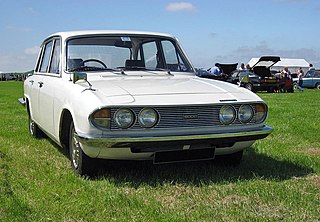 W
WThe Triumph 2000 is a mid-sized, rear wheel drive automobile which was produced in Coventry by the Triumph Motor Company between 1963 and 1977. It was introduced on 15 October 1963.
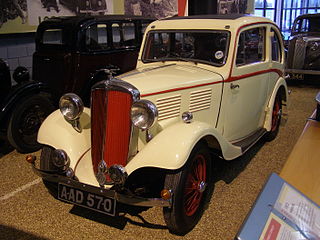 W
WThe Standard Ten was a model name given to several small cars produced by the British Standard Motor Company between 1906 and 1961. The name was a reference to the car's fiscal horsepower, a function of the surface area of the pistons. This system quickly became obsolete as an estimate of the power produced by the engine, but it continued to be relevant as a way to classify cars for tax purposes. Like other manufacturers, Standard continued to use the name to define the approximate size of their 'Ten' model long after the origins of the name had, in Britain, become inapplicable.
 W
WThe Triumph Herald is a small two-door car introduced by Standard-Triumph of Coventry in 1959 and made through to 1971. The body design was by the Italian stylist Giovanni Michelotti, and the car was offered in saloon, convertible, coupé, estate and van models, with the latter marketed as the Triumph Courier.
 W
WThe Triumph 1300 is a medium/small 4-door saloon car that was made between 1965 and 1970 by Standard Triumph in Coventry, England, under the control of Leyland Motors. It was introduced at the London Motor Show in October 1965 and intended as a replacement for the popular Triumph Herald. Its body was designed by Michelotti in a style similar to the larger Triumph 2000. It was replaced by the Triumph 1500, though it was also re-engineered in the early 1970s to provide the basis for the Toledo and Dolomite ranges.
 W
WThe Triumph 1500 is a small front-wheel drive car that was produced by Standard-Triumph from 1970 to 1973. In 1973 it was revised as the Triumph 1500TC becoming rear-wheel drive. Production ended in 1976, by which time it had been replaced by the Triumph Dolomite.
 W
WThe Triumph 2000 is a mid-sized, rear wheel drive automobile which was produced in Coventry by the Triumph Motor Company between 1963 and 1977. It was introduced on 15 October 1963.
 W
WThe Triumph 2000 is a mid-sized, rear wheel drive automobile which was produced in Coventry by the Triumph Motor Company between 1963 and 1977. It was introduced on 15 October 1963.
 W
WThe Triumph Acclaim is a front-wheel drive compact family saloon/sedan manufactured by British Leyland (BL) from 1981 to 1984. It is based on the Honda Ballade. It used a Honda-designed engine, was manufactured under license from Honda, and met United Kingdom component-content requirements. It was the final model of the Triumph marque.
 W
WThe Standard Atlas is a light van which was produced and sold under various names between 1958 and 1980, initially in Britain and Europe, and subsequently in India.
 W
WThe Triumph 2000 is a mid-sized, rear wheel drive automobile which was produced in Coventry by the Triumph Motor Company between 1963 and 1977. It was introduced on 15 October 1963.
 W
WThe Triumph Herald is a small two-door car introduced by Standard-Triumph of Coventry in 1959 and made through to 1971. The body design was by the Italian stylist Giovanni Michelotti, and the car was offered in saloon, convertible, coupé, estate and van models, with the latter marketed as the Triumph Courier.
 W
WThe Triumph Dolomite small saloon car was produced by the Triumph Motor Company division of the British Leyland Corporation in Canley, Coventry between October 1972 and August 1980.
 W
WThe Triumph Dolomite is a car that was produced by Triumph Motor Company from 1934 to 1940. It first appeared in 1934 as a sports car and the name was also used from 1937 on a series of sporting saloons and open cars until 1939 when the company went into receivership. A number were still sold and registered in 1940, though it is uncertain whether the receiver or new owner turned out cars from spare parts, or sold off completed cars. All except the Straight 8 featured a "waterfall" grille styled by Walter Belgrove, versions of the saloons with conventional grilles were sold as Continental models.
 W
WThe Triumph Dolomite small saloon car was produced by the Triumph Motor Company division of the British Leyland Corporation in Canley, Coventry between October 1972 and August 1980.
 W
WThe Triumph Fury was a two-door convertible prototype by the Standard-Triumph Company of Coventry. It was the first monocoque sports car to be made by Triumph. Body design was by the Italian stylist Giovanni Michelotti and the car used components from the 2000 saloon including the 2.0L 6-cylinder engine of the time, although the use of the 2.5L 6-cylinder or the 3.0L Triumph V8 was possibly intended, had the car gone into production. The car lost out to the continuation of the separate-chassis TR series, with the Triumph TR5 being introduced in August 1967. The decision by Triumph to not develop the car was due in part to the reluctance to invest in new production line and tooling facilities required to manufacture the model, in favour of continuing with the simpler manufacturing of the separate body and chassis design of the TR series.
 W
WThe Triumph Gloria is a car which was produced by the Triumph Motor Company in Coventry, England, from 1934 to 1938.
 W
WThe Triumph GT6 is a 6-cylinder sports coupé built by Standard-Triumph, based on their popular Triumph Spitfire convertible. Production ran from 1966 to 1973.
 W
WThe Triumph Herald is a small two-door car introduced by Standard-Triumph of Coventry in 1959 and made through to 1971. The body design was by the Italian stylist Giovanni Michelotti, and the car was offered in saloon, convertible, coupé, estate and van models, with the latter marketed as the Triumph Courier.
 W
WThe Triumph Italia 2000 Coupé was built between 1959 and 1962, during which time 330 cars were produced. Designed by Giovanni Michelotti, the TR3 chassis and mechanical components were supplied by the Triumph Motor Company in the United Kingdom, and built by Alfredo Vignale in Turin, Italy.
 W
WThe Triumph Mayflower is a British four-seat 1+1⁄4-litre small luxury car noted for its razor-edge styling. It was built by the Standard Motor Company and sold by Standard's subsidiary, The Triumph Motor Company. It was announced at the October 1949 British International Motor Show, but deliveries did not commence until the middle of 1950. One of the nine prototype Triumph Mayflowers, "JWK 612", was factory tested 5000 miles across Europe in 1950, they used the famous rooftop test track of Impéria Automobiles in Belgium. The Mayflower was manufactured from 1949 until 1953.
 W
WThe Triumph Renown is strictly the name given to the Triumph's large saloon car made from 1949 to 1954 but it is, in reality, part of a three-car series of the 1800, 2000 and Renown models. Together with the Triumph Roadster, they were the first vehicles to carry the Triumph badge following the company's takeover by the Standard Motor Company.
 W
WThe Triumph Roadster is a roadster which was produced by Britain's Standard Motor Company from 1946 to 1949. It was first available as the Triumph 1800 Roadster (18TR) from 1946 to 1948 and then as the Triumph 2000 Roadster (TRA) from 1948 to 1949.
 W
WThe Triumph Spitfire is a British front-engined, rear-wheel drive, two-passenger convertible sports car introduced at the London Motor Show in 1962 and manufactured between 1962-1980. Styled for Standard-Triumph in 1957 by Italian designer Giovanni Michelotti, the Spitifire was manufactured for the duration of its production at the Standard-Triumph Canley works — and evolved over a series of five production iterations, with a approximately 315,000 manufactured over 18 years.
 W
WThe Triumph Stag is a 2+2 sports tourer which was sold between 1970 and 1978 by the British Triumph Motor Company, styled by Italian designer Giovanni Michelotti.
 W
WThe Triumph Super 7 was a car manufactured from 1927 to 1934 by the Triumph Motor Company. It was produced as a response to the success of the Austin 7 and was Triumph's first car to be made in large numbers. In 1933 the name was changed to the Triumph Super 8.
 W
WThe Triumph Super 9 was first introduced by the Triumph Motor Company in 1931 at a price of £185. It continued through into 1933. It had an RAC rating of 8.9 hp.
 W
WThe Triumph Toledo is a compact car which was produced by the Rover-Triumph division of British Leyland in the United Kingdom from 1970 to 1976.
 W
WThe Triumph TR range of cars was built between 1953 and 1981 by the Triumph Motor Company in the United Kingdom. Changes from the TR2 to the TR6 were mostly evolutionary, with a change from a live axle to independent rear suspension in 1965 and a change from a four-cylinder engine to a six-cylinder engine in 1967. An all-new TR7, with a unit body, an overhead camshaft four-cylinder engine, and a live rear axle, was introduced in late 1974. The TR8, a development of the TR7 with a Rover V8 engine, was introduced in 1979 and was sold alongside the TR7 until TR production ended.
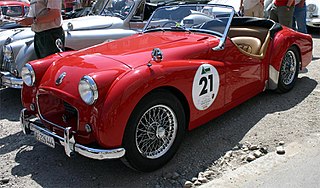 W
WThe Triumph TR2 is a sports car produced by the Standard Motor Company in the United Kingdom between 1953 and 1955. It was only available in roadster form.
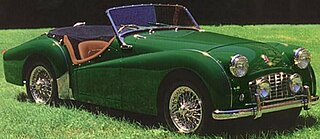 W
WThe Triumph TR3 is a British sports car produced between 1955 and 1962 by the Standard-Triumph Motor Company of Coventry, England. A traditional roadster, the TR3 is an evolution of the company's earlier TR2 model, with greater power and improved braking. Updated variants, popularly but unofficially known as the "TR3A" and "TR3B", entered production in 1957 and 1962 respectively. The TR3 was succeeded by the Michelotti-styled, mechanically similar Triumph TR4.
 W
WThe Triumph TR4 is a sports car produced by the Triumph Motor Company from 1961 to 1965. As the successor to the TR3A, the car was based on the chassis and drivetrain of the previous TR sports cars, but with a modern body designed by Michelotti.
 W
WThe Triumph TR4A is a sports car built by the Triumph Motor Company at its Coventry factory in the United Kingdom between 1965 and 1967.
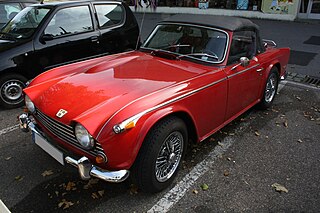 W
WThe Triumph TR5 is a sports car built by the Triumph Motor Company in Coventry, England, between August 1967 and September 1968.
 W
WThe Triumph TR6 (1968–76) is a sports car built by British Triumph Motor Company between 1969 and 1976. The TR6 was introduced in January 1969 and was produced through July 1976. The first series have commission numbers commencing with CP or CC. CP designating petrol injection and CC designating carburettors for the US market. The first bodies were built at Liverpool, in September 1968 and by December 1968 1,468 USA spec TR6s had been assembled at Canley, along with 51 export-market TR6PIs, home UK market assembly did not begin until the first few days of January 1969. The PI model has a brake horse power of 150, whereas for the US model, it is 104 bhp. The TR6 was the best-seller of the TR range when production ended, a record subsequently surpassed by the TR7. Of the 91,850 TR6s produced, 83,480 were exported; only 8,370 were sold in the UK.
 W
WThe Triumph TR7 is a sports car manufactured in the United Kingdom from September 1974 to October 1981, until May 1975, by the Rover-Triumph Division of the British Leyland Motor Corporation (BLMC) and, thereafter, by the Specialist Division of British Leyland (BL). It was initially produced at the Speke, Liverpool, factory, moving to Canley, Coventry, in 1978 and then finally to the Rover Solihull plant in 1980. The car was launched in the United States in January 1975, with its UK home market debut in May 1976. The UK launch was delayed at least twice because of high demand for the vehicle in the US, with final sales of new TR7s continuing into 1982.
 W
WThe Triumph TR8 is an eight-cylinder version of the "wedge-shaped" Triumph TR7 sports car, designed by Harris Mann, and manufactured by British Leyland (BL), through its Jaguar/Rover/Triumph (JRT) division. Because of its outstanding performance, the TR8 was often dubbed the "English Corvette". The majority of TR8s were sold in the United States and Canada.
 W
WThe Triumph TR5 is a sports car built by the Triumph Motor Company in Coventry, England, between August 1967 and September 1968.
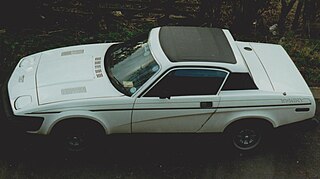 W
WThe Triumph TR7 Sprint version of the Triumph TR7 sports car was produced in 1977 by the Triumph Motor Company then part of British Leyland. However, it was produced in only very limited numbers: Probably a maximum of 61 in total were manufactured. It used the 127 bhp, 16-valve, 2-litre version of the Triumph slant-four engine from the Triumph Dolomite Sprint, a highly tuned version of which, "rated at 225 bhp at 8000 rpm" by 1977, was used in the Group 4 TR7 cars of the BL works rally team, from 1976 until 1978. This was instead of the TR7 base model's 105 bhp, 8-valve, 2-litre version of the same basic slant-4 engine. The 16-valve version was originally specified in the Dolomite Sprint at 135 bhp, and "Spenser King relates how he went away on holiday and came back to find an engine running on the bed giving 150 bhp at the first build."
 W
WThe Triumph Vitesse is a compact six-cylinder car built by Standard-Triumph from May 1962 to July 1971. The car was styled by Giovanni Michelotti, and was available in saloon and convertible variants.